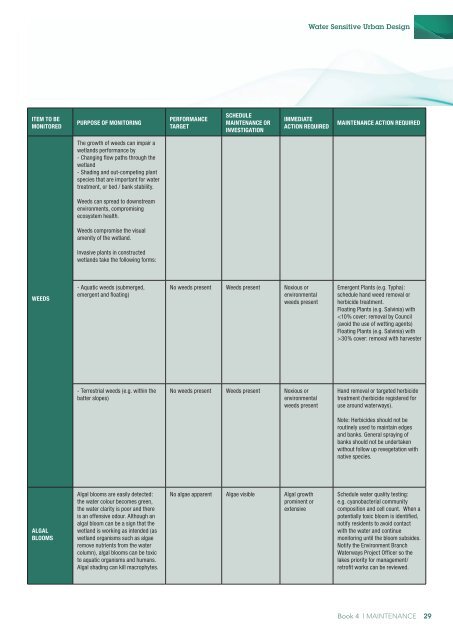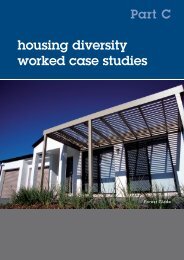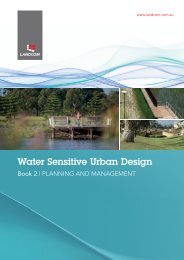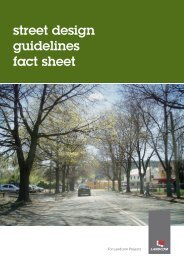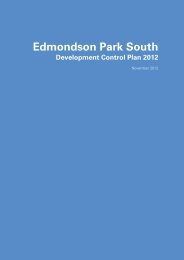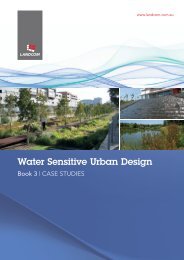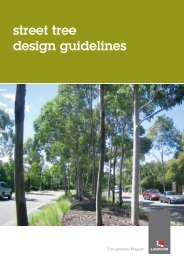Landcom Book 4 Maintenance - WSUD
Landcom Book 4 Maintenance - WSUD
Landcom Book 4 Maintenance - WSUD
Create successful ePaper yourself
Turn your PDF publications into a flip-book with our unique Google optimized e-Paper software.
Water Sensitive Urban Design<br />
Item to be<br />
Monitored<br />
Purpose of Monitoring<br />
Performance<br />
Target<br />
Schedule<br />
<strong>Maintenance</strong> or<br />
Investigation<br />
Immediate<br />
Action Required<br />
<strong>Maintenance</strong> Action Required<br />
The growth of weeds can impair a<br />
wetlands performance by<br />
- Changing flow paths through the<br />
wetland<br />
- Shading and out-competing plant<br />
species that are important for water<br />
treatment, or bed / bank stability.<br />
Weeds can spread to downstream<br />
environments, compromising<br />
ecosystem health.<br />
Weeds compromise the visual<br />
amenity of the wetland.<br />
Invasive plants in constructed<br />
wetlands take the following forms:<br />
Weeds<br />
- Aquatic weeds (submerged,<br />
emergent and floating)<br />
No weeds present Weeds present Noxious or<br />
environmental<br />
weeds present<br />
Emergent Plants (e.g. Typha):<br />
schedule hand weed removal or<br />
herbicide treatment.<br />
Floating Plants (e.g. Salvinia) with<br />
30% cover: removal with harvester<br />
- Terrestrial weeds (e.g. within the<br />
batter slopes)<br />
No weeds present Weeds present Noxious or<br />
environmental<br />
weeds present<br />
Hand removal or targeted herbicide<br />
treatment (herbicide registered for<br />
use around waterways).<br />
Note: Herbicides should not be<br />
routinely used to maintain edges<br />
and banks. General spraying of<br />
banks should not be undertaken<br />
without follow up revegetation with<br />
native species.<br />
Algal<br />
blooms<br />
Algal blooms are easily detected:<br />
the water colour becomes green,<br />
the water clarity is poor and there<br />
is an offensive odour. Although an<br />
algal bloom can be a sign that the<br />
wetland is working as intended (as<br />
wetland organisms such as algae<br />
remove nutrients from the water<br />
column), algal blooms can be toxic<br />
to aquatic organisms and humans.<br />
Algal shading can kill macrophytes.<br />
No algae apparent Algae visible Algal growth<br />
prominent or<br />
extensive<br />
Schedule water quality testing:<br />
e.g. cyanobacterial community<br />
composition and cell count. When a<br />
potentially toxic bloom is identified,<br />
notify residents to avoid contact<br />
with the water and continue<br />
monitoring until the bloom subsides.<br />
Notify the Environment Branch<br />
Waterways Project Officer so the<br />
lakes priority for management/<br />
retrofit works can be reviewed.<br />
<strong>Book</strong> 4 | MAINTENANCE 29


